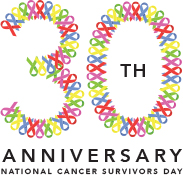
Sunday, June 4, 2017, marks the 30th anniversary of National Cancer Survivors Day. Here’s a look at the progress that has been made over the past 2 to 3 decades in reducing cancer incidence and cancer deaths and the challenges that remain.
Increasing Rates of Cancer Survivorship
In 1971, the number of cancer survivors in the United States was 3 million. Today, that number is approximately 15.5 million and is projected to increase by 31% to 20.3 million by 2026, an increase of more than 4 million survivors in 10 years. By 2040, the number of cancer survivors is expected to grow to 26.1 million, an increase of nearly 11 million from 2016.1 Over the next decade, the number of survivors who have lived 5 years or more after their cancer diagnosis is expected to increase approximately 35%, to 14 million.
Decline in Cancer Deaths
Between 1991 and 2014, the cancer death rate has declined by 25% in the United States. The reduction equates to 2.1 million fewer cancer deaths during this period. In 2017, there will be 1,688,780 new cancer cases and 600,920 cancer deaths in the United States.2 Over the past decade, the overall cancer incidence rate was stable in women and declined by about 2% annually in men, while the cancer death rate declined by about 1.5% annually in both men and women. However, there are significant gender disparities in cancer incidence and mortality. For all sites combined, the cancer incidence rate is 20% higher in men than in women, whereas the cancer death rate is 40% higher in men.
Workplace Support for Cancer Survivors
Cancer Survivors in the United States
- By 2040, the number of cancer survivors is expected to grow to 26.1 million, an increase of nearly 11 million from 2016
According to an international survey of 500 senior executives in 20 countries, including the United States, 60% provide workplace adjustments to employees living with cancer, 54% offer compassionate leave beyond nationally set limits for employees caring for a family member with cancer, and 49% offer occupational or company sick pay to employees with cancer. Overall, 74% of the respondents said they are confident that their employers would support them during the period of illness and up to 1 year thereafter.3
Global Impact of Cancer
Cancer is the second leading cause of death globally, and was responsible for 8.8 million deaths in 2015.4 Globally, nearly 1 in 6 deaths is due to cancer. In addition:
- About 70% of deaths from cancer occur in low- and middle-income countries.
- Tobacco use is the most important risk factor for cancer and is responsible for approximately 22% of cancer deaths.
- Cancer-causing infections, such as hepatitis and human papillomavirus, are responsible for up to 25% of cancer cases in low- and middle-income countries.
- Around one-third of deaths from cancer are due to the five leading behavioral and dietary risks, including high body mass index, low fruit and vegetable intake, lack of physical activity, tobacco use, and alcohol use.
Economic Impact of Cancer Care
National expenditures for cancer care have been steadily increasing in the United States. In 2010, care for cancer survivors accounted for an estimated $137.4 billion in medical care expenditures.5 In 2016, the national economic burden of cancer care in the United States rose to $143.8 billion. National expenditures were largest for lymphoma and female breast, colorectal, prostate, and lung cancers.6
References
2. Siegel RL, Miller KD, Jemal A: Cancer statistics, 2017. CA Cancer J Clin 67:7-30, 2017.
3. Economist Intelligence Unit: Global cancer survivorship: The need for integrated care. Available at cancersurvivorship.eiu.com. Accessed April 19, 2017.
4. World Health Organization: Cancer fact sheet, February 2017. Available at www.who.int. Accessed April 19, 2017.
5. National Cancer Institute: Financial burden of cancer care. Cancer Trends Progress Report, January 2017. Available at progressreport.cancer.gov. Accessed April 19, 2017.

